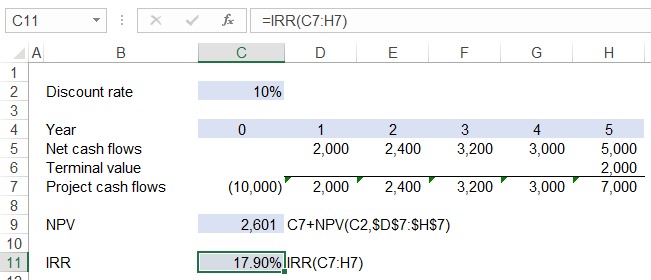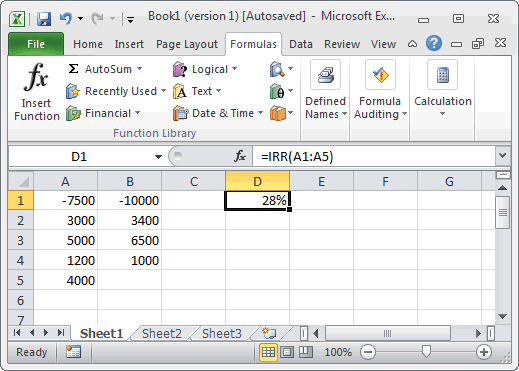Excel IRR Function and Other Ways to Calculate IRR in Excel
- The internal rate of return (IRR) for a project can be defined as the discount rate that offers zero net present value (NPV) or the rate where the present value of the initial investment or cash outflows is the same amount as the present value of the future cash inflows that are associated with a project.
- The mathematical IRR algorithm and especially the Excel implementation are erratic. Sometimes, it helps to 'drill' down into the NPV curve; for example, using the range -20.0%, -19.9%, etc to -12.9%. And sometimes, the Excel IRR, XIRR or RATE function simply fails.
- In Excel, you can also use the =YEARFRAC function to automatically adjust this calculation for different dates. The formula is as follows: =X. (1 + IRR)^YEARFRAC (date1,date2) Where X is the investment made, IRR is the desired IRR, 'date1' is the investment date and 'date2' is the exit date.
IRR is a discount rate, whereby NPV equals to zero. You might use the following Excel function: =IRR(paymentsrange) There is no exact and universal formula for the IRR valuation; therefore, only approximate methods are used in practice. For example, you might use the GoalSeek function in Excel.
Download Excel WorkbookDownload the workbook
The internal rate of return (IRR) is a common source of error in a financial model. This tutorial covers how to calculate an IRR in Excel, and assumes that the reader is already familiar with the mathematical concept of the IRR.
This tutorial discusses methods to calculate IRR using a trial and error method or using a 1-Dimension data table. It also explains how to calculate IRR using NPV or XIRR in Excel.
Key Learnings
- What is the best way to calculate the IRR of a set of cash flows?
- Calculate IRR using the trial and error method
- Unsing a 1-Dimension data table to spot the root
- Using IRR() in Excel
- Using XIRR() in Excel
- Common applications of IRR
The internal rate of return (IRR) is a common source of error in a financial model. This tutorial covers how to calculate an IRR in Excel, and assumes that the reader is already familiar with the mathematical concept of the IRR.
The IRR can be defined as a discount rate which, when applied to a series of cash flows, generates a nil net present value (NPV). There may be more than one IRR in certain situations; additionally, Excel makes this calculation deceptively simple, at the risk of errors.
The NPV is the discounted value of a stream of cash flows generated from a project or investment. IRR computes the break even rate of return for which the NPV equals to zero. It is an indicator of the efficiency or quality of an investment, as opposed to the NPV which indicates value or magnitude.
The IRR is the annualised effective compounded return rate, denoted by ‘r’. Mathematically, it can be formulated as:
What is the best way to calculate the IRR of a set of cash flows?
In this tutorial we will discuss the possible methods to calculate the IRR:
- Using a trial and error method (to assist understanding)
- Using a 1-dimension data table
- Calculating IRR using Excel function NPV()
- Calculating IRR using XIRR
The downloadable Excel workbook above has been prepared to demonstrate the IRR calculation. For ease of reference, we recommend you download the workbook while reading this tutorial.
Trial and error method for IRR calculations in Excel
IRR is the discount rate for which NPV equals zero, and could be calculated by a trial and error process.
- NPV(IRR(…), …) = 0
- XNPV(XIRR(…), …) = 0
The trial and error process is as follows:
- Start with a guess of the discount rate ‘r’
- Calculate NPV using the ‘r’ – refer to our tutorials on how to calculate an NPV with or without Excel formulae
- If the NPV is close to zero, then ‘r’ is the IRR
- If the NPV is positive, increase ‘r’
- If the NPV is negative, decrease ‘r’
- Continue the process until NPV reaches zero
Using the example in the workbook:

- Refer to screenshot 1: The NPV calculated at a discount rate of 10% is $19.31 million, hence we know that the IRR should be greater than 10%
- Refer to screenshot 2: Let us now try ‘r’ of 18%. The NPV is -$0.87 million. It is negative, but the NPV is closer to zero this time.
- Therefore, we could guess that the IRR should be slightly lower than 18%.
- The trial and error process can be more tedious than calculating an NPV itself.
- Next, we will show you the approach of guessing the IRR with the help of a 1-dimension data table.
Using a 1-dimension data table to spot the root
We recommended presenting NPV at various discount rates using a quick 1-dimension data table, with discount rates as the vertical parameter as shown in screenshot 3.
Let us plot the above data table in a chart – see screenshot 4. It becomes clear that the IRR is between 17.50% and 18.00%. To be precise, the IRR is 17.53%, which we could get using the Excel function.
Using IRR() in Excel
IRR() syntax:
IRR(CF1, CF2, …)
We could calculate IRR using Excel function IRR(), but similar to NPV(), it has some limitations:
- The cash flows (CFi) must be equally spaced in time and occur at the end of each period
- The CFi must be entered in the correct sequence
Using XIRR() function In Excel
Due to its limitation, the IRR function (without the X) is best avoided. The more robust function would be XIRR(). It returns the internal rate of return for a schedule of cash flows that is not necessarily periodic.
XIRR() is an added-in function in Excel and the syntax is: XIRR(CFi, dates)
As demonstrated in screenshot 5, the calculated IRR is 17.53%. We could double check the calculation by feeding the IRR back into the NPV calculation as a discount rate, for which NPV equals zero.
Common Applications of IRR
Capital budgeting: Investment decision tool
IRR is a metric to decide whether a single project is worth investing in. Theoretically, a simple decision making benchmark could be set to accept a project if the IRR exceeds the cost of capital, and rejected if this IRR is less than the cost of capital.
You should be aware of the limitation of the IRR, such as a project with multiple IRRs or no IRR. In addition, IRR neglects the size of the project, and assumes that cash flows are reinvested at a constant rate.
Tariff optimisation

Irr To Work In Excel Spreadsheet
IRR is commonly used in optimising the toll/tariff regime in project finance transactions, such as in public, private partnerships (PPP) schemes. This could be done during the bidding process based on the expected IRR. Alternatively, a tariff could be adjusted in order to provide a minimum IRR threshold for the concessionaire.
Corality Academy: Corality Financial Modelling Campus
There are numerous other tutorials and free resources related to financial modelling in the Corality Financial Modelling Campus.
How To Irr In Excel
Some of the more popular courses that relate to this topic include: